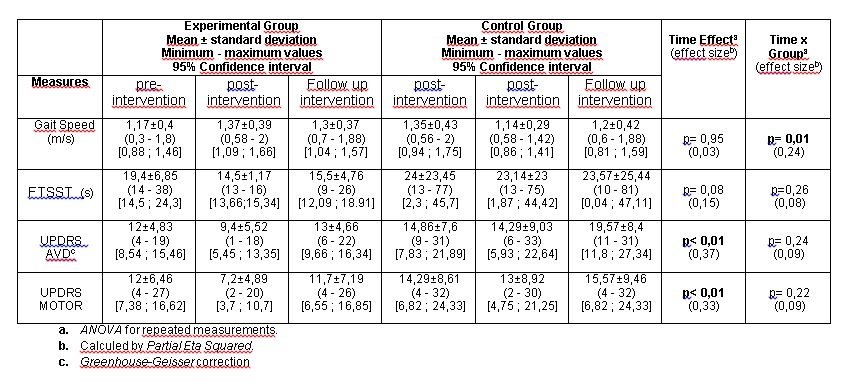Session Information
Date: Sunday, October 7, 2018
Session Title: Other
Session Time: 1:45pm-3:15pm
Location: Hall 3FG
Objective: The objective of the study was to verify the effects of APT on functional abilities of people with PD.
Background: In the biopsychosocial model are found the domains body function and structure, activity, participation and contextual factors: environmental and personal factors. This mapping is the basis of classification ICF developed by World Health Organization1. In Parkinson’s Disease (PD) there is motor and non-motor impairment with repercussions on body functions and structures, in addition to the contexts of activities and participation1,2. Loss of independence occurs, limiting capacity and performance. However, training with functional activities recruits cortical centers of movement control and cognition, which may stimulate neuroplasticity, affecting activities and participation. A Aquatic Physical Therapy (APT) is a differentiated and safe environmental facilitators in the process of learning and motor recovery of PD2.
Methods: Seventeen participants were assessed for age, sex, diagnostic time, Hoehn and Yahr scale (HY), gait speed, Five Times Sit to Stand Test (FTSST), Unified Parkinson’s Disease Rating Scale (UPDRS) part II and III: activities of daily living (ADLs) and motor, respectively. The APT intervention was proposed during 32 sessions of 50 minutes, 2 times a week, with a focus on motor stimulus and attention. At all meetings the participants were encouraged to repeat and improve the proposed exercises. We compare the performance of the participants in the Experimental Group (EG=10) and Control Group (CG=7 not exposed to APT) in 3 evaluations: pre-intervention, post-intervention and follow-up 4 months after the intervention.
Results: The mean age EG= 63 and CG= 66.5, HY EG = 2, CG = 2, mean diagnostic time of 96 months for both groups. EG= 6 women and 5 men, CG = 3 women and 5 men. The statistics are indicated in table 1 [table1].
Conclusions: The APT is able to modify the performance and capacity of motor skills with probable functional transfer to the terrestrial environment, favoring the activity and participation of people with PD, reducing Limitations and Restrictions.
References: 1. Christofoletti G; Freitas RT; Rocha CE; Cardoso CS. Eficácia de tratamento fisioterapêutico no equilíbrio estático e dinâmico de pacientes com doença de Parkinson. Fisioter. Pesqui. [Internet]. 2010 Sep [cited 2018 Mar 05]; 17( 3 ): 259-263. 2. Vojciechowski AS, Zotz TGG, Loureiro APC, Israel. VL. The International Classification of Functioning,. Disability and Health as applied to Parkinson’s disease: a literature review. Adv Parkinson’s Dis. 2016;5(2):29-40. DOI: http://dx.doi.org/10.4236/ apd.2016.52005.
To cite this abstract in AMA style:
V. Israel, B. Yamaguchi, M. Ferreira. Effects of Aquatic Physical Therapy on Parkinson’s disease under a vision of the International Classification of Functioning, Disability and Health (ICF) [abstract]. Mov Disord. 2018; 33 (suppl 2). https://www.mdsabstracts.org/abstract/effects-of-aquatic-physical-therapy-on-parkinsons-disease-under-a-vision-of-the-international-classification-of-functioning-disability-and-health-icf/. Accessed April 1, 2025.« Back to 2018 International Congress
MDS Abstracts - https://www.mdsabstracts.org/abstract/effects-of-aquatic-physical-therapy-on-parkinsons-disease-under-a-vision-of-the-international-classification-of-functioning-disability-and-health-icf/

